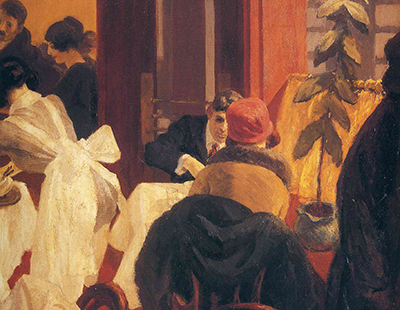Edward Hopper (July 22, 1882 –May 15, 1967) was an American realist artist. Famous for his paintings of American urban and rural life, his work still remains extremely popular.
Hopper’s work first gained recognition in the 1920’s, and by the 1930’s his pieces were selling for thousands of dollars. In 1942 he painted, arguably, his most famous work, “Nighthawks.”
“New York Restaurant” is an oil painting, on canvas, painted in 1922. Although created early in his career, its style is a precursor of what was to follow.
The painting depicts a man, and his girlfriend, sitting at a table. They are in deep conversation, while the day to day activity of the restaurant carries on around them. We can only see the back of the woman, who is wearing a red hat, which partially obscures the man’s face.
Typical of Hopper’s work, the painting captures a specific moment in time. Instead of telling a story, the painting simply displays a scene, leaving the viewer to form their own interpretation of the work.
Hopper manages to make the man and women the focal point of the painting, despite the many images that surround them. The waitress, with her bright white uniform, the potted plant beside the table, a coat draped over a chair and another hanging in the foreground, while all noticeable, do not detract from the main subject of the work.
The use of light, colour, and shade are typical of Hopper’s work. The crisp white tablecloths, combined with the waitress’ uniform, contrast sharply with the dark clothing of the diners, and their surroundings.
In, what seems to be a simple painting, Hopper manages to evoke the atmosphere of a lively, lunchtime restaurant. From the waitress busying herself at the table, to the patrons in the background, the impression is one of a crowded New York eatery.
Throughout his career, Hopper maintained the same style, ignoring trends. As a result, his work is as recognisable today, as it was in the 1920’s.




